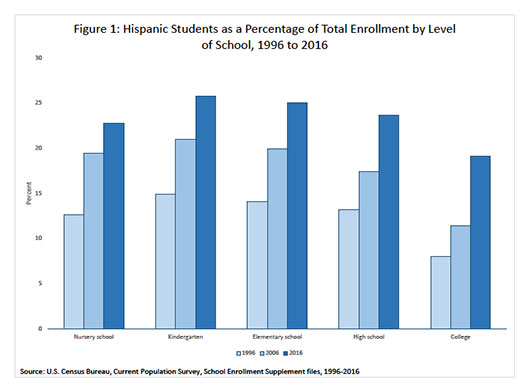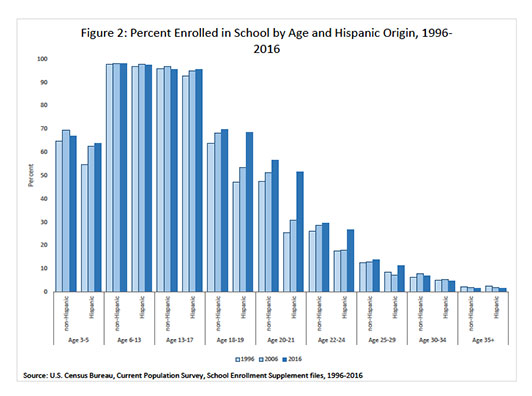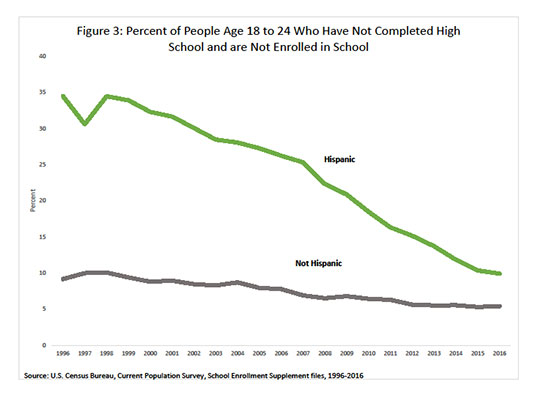School Enrollment of the Hispanic Population: Two Decades of Growth
School Enrollment of the Hispanic Population: Two Decades of Growth
The Hispanic population of the United States is large and growing. More than half of the growth in the total population of the United States between 2000 and 2010 was due to the increase in the Hispanic population. By 2016, Hispanics numbered 57.5 million (17.9 percent), making them the largest ethnic or racial minority in the United States.
The growth in the Hispanic population has been accompanied by a growth in the Hispanic student population. From 1996 to 2016, the number of Hispanic students enrolled in schools, colleges and universities in the United States doubled from 8.8 million to 17.9 million. Hispanic students now make up 22.7 percent of all people enrolled in school.
The increase in Hispanic enrollment is seen at all levels of education from nursery school to college. The share of nursery school students who are Hispanic increased from 12.7 percent to 22.7 percent in the period 1996 to 2016 (Figure 1). At the kindergarten level, the Hispanic share rose from 14.9 percent to 25.7 percent. The share of elementary school students (grades 1 to 8) went from 14.1 to 25.0 percent, high school went from 13.2 percent to 23.7 percent, and college and university students went from 8.0 percent to 19.1 percent.

The increase in Hispanic enrollment has resulted not only from population growth, but also from increased school attendance rates. Figure 2 shows enrollment rates by age and Hispanic origin over the past two decades. Growth in enrollment rates by age for Hispanics were especially evident at the youngest ages and the 18- to 24-year-old group. The percentage enrolled grew by 8.8 percentage points among Hispanics ages 3 to 5, while non-Hispanics experienced a 2.3-point gain. At ages 18 to 19, Hispanic enrollment experienced a 21.4 percentage point increase, compared with 5.9 percentage points for non-Hispanics. At ages 20 to 21, the gains were 26.4 percentage points for Hispanics and 9.1 percentage points for non-Hispanics. At 22 to 24 years, the gains were 9.1 and 3.3 percentages points, respectively.

The increase in enrollment among young adults is also associated with increases in high school completion and college attendance. In 1996, 34.5 percent of Hispanics between the ages of 18 and 24 had not completed high school and were not attending school (Figure 3). By 2016, this rate had fallen by two-thirds to 9.9 percent. The comparable rates for non-Hispanics went from 9.2 percent to 5.4 percent over the same time period.
The growth in college enrollment among Hispanics has been especially pronounced in the last decade. After growing by 0.7 million from 1996 to 2006, the college enrollment of Hispanics went up by 1.7 million from 2006 to 2016. The result has been an overall tripling of college enrollment by Hispanics over the past two decades.

Figure 4 shows trends in college enrollment among Hispanic students. A notable feature of the patterns visible here is the large proportion of Hispanic students in two-year colleges. An increase in two-year enrollment took place in the five-year period 2006 to 2011, where it grew by nearly 600,000. By 2011, 42.9 percent of Hispanic college students were in two-year schools, compared with 24.1 percent of whites, 32.9 percent of blacks and 17.3 percent of Asians. The most recent five-year period (2011 to 2016) produced a shift in this pattern. Hispanic enrollment in two-year colleges held steady, while enrollment in four-year colleges grew by almost 700,000. Thanks to this recent trend, four-year colleges accounted for 1.5 million of the overall 2.4 million growth in college enrollment over the past 20 years.

In spite of the many positive trends seen here, there are still gaps separating Hispanics from other groups in overall education. The proportion of Hispanics between 18 and 24 years’ old who have not completed high school and are not enrolled in school is still higher than that of non-Hispanics. Enrollment in graduate or professional school still lags that of other groups. Among the population ages 25 to 34, graduate school enrollment is 4.2 percent for non-Hispanic whites, 4.0 percent for blacks, (not significantly different from non-Hispanic whites), 7.6 percent for Asians and 1.9 percent for Hispanics. Nonetheless, the past two decades have seen progress in school enrollment for Hispanics by nearly every measure.
###





